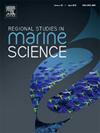印度东南部帕尔克湾和马纳尔湾沿海沉积物和盐沼重金属污染的环境影响
IF 2.4
4区 环境科学与生态学
Q3 ECOLOGY
引用次数: 0
摘要
本研究调查了印度东南部帕尔克湾和马纳尔湾盐沼植物重金属的生物积累,强调了金属吸收的季节性变化(季风和夏季)。对11种植物,包括盐藓、石竹和海苔,进行了2个季节植物组织和沉积物中镉(Cd)、铬(Cr)、铜(Cu)、铅(Pb)和锌(Zn)浓度的分析。结果表明,季风期间金属积累量较大,盐藓和利托藓对Cu、Zn和Cr的吸收较多。根据Igeo标准,夏季沉积物中Cd污染可忽略,Cr和Cu污染较低,Zn污染中等。调查结果表明,沉积物中重金属污染为:季风区Cd >; Pb >; Cr >; Cu >; Zn;Cr >; Cu >; Zn >; Pb >; 夏季的Cd。污染程度(CD)和潜在生态风险(PER)指数表明S5、S8和S9站是值得关注的区域,特别是在夏季。本研究强调了盐沼植物是沿海生态系统重金属污染的有效生物指标。本文章由计算机程序翻译,如有差异,请以英文原文为准。
Environmental impact of heavy metal contamination in coastal sediments and saltmarshes of Palk Bay and Gulf of Mannar, Southeast India
This current study investigates the bioaccumulation of heavy metals in salt marsh plants from Palk Bay and the Gulf of Mannar, Southeast India, emphasizing seasonal variations (Monsoon and Summer) in metal uptake. Eleven plant species, including A. halimus, S. littoreus, and S. maritima, were analysed across two seasons for cadmium (Cd), chromium (Cr), copper (Cu), lead (Pb), and zinc (Zn) concentrations in plant tissues and sediments. Results indicate higher metal accumulation during monsoon, with substantial uptake of Cu, Zn, and Cr by A. halimus and S. littoreus. Igeo standards for sediments suggests negligible Cd contamination, low Cr and Cu contamination, and moderate Zn contamination during summer. The investigation concluded that the heavy metal contamination in sediments was noted as, Cd > Pb > Cr > Cu > Zn for monsoon; Cr > Cu > Zn > Pb > Cd for summer seasons. The Contamination Degree (CD) and Potential Ecological Risk (PER) indices identified stations S5, S8, and S9 as areas of concern, especially in summer. This study highlights salt marsh plants as effective bioindicators of heavy metal pollution in coastal ecosystems.
求助全文
通过发布文献求助,成功后即可免费获取论文全文。
去求助
来源期刊

Regional Studies in Marine Science
Agricultural and Biological Sciences-Ecology, Evolution, Behavior and Systematics
CiteScore
3.90
自引率
4.80%
发文量
336
审稿时长
69 days
期刊介绍:
REGIONAL STUDIES IN MARINE SCIENCE will publish scientifically sound papers on regional aspects of maritime and marine resources in estuaries, coastal zones, continental shelf, the seas and oceans.
 求助内容:
求助内容: 应助结果提醒方式:
应助结果提醒方式:


